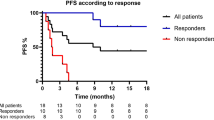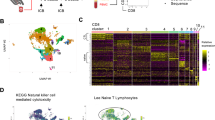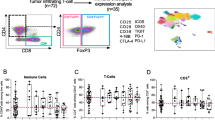Abstract
The inhibitory immune checkpoint PD-L1/PD1 promotes the alternative splicing of the FKBP5 gene, resulting in increased expression of its variant 4 in the peripheral blood mononuclear cells of melanoma patients. The variant 4 transcript is translated into the truncated FKBP51s protein. Given the importance of co-inhibitory signalling in tumour immune escape, here we tested the potential for using FKBP51s expression to predict immunotherapy outcomes. To do this, we immunophenotyped PBMCs from 118 melanoma patients and 77 age- and sex-matched healthy controls. Blood samples were collected before patients underwent ipilimumab treatment. In 64 of the 118 patients, FKBP51s expression was also assessed in regulatory T cells (Tregs). We found that each PBMC subset analysed contained an FKBP51spos fraction, and that this fraction was greater in the melanoma patients than healthy controls. In CD4 T lymphocytes, the FKBP51sneg fraction was significantly impaired. Tregs count was increased in melanoma patients, which is in line with previous studies. Also, by analyses of FKBP51s in Tregs, we identified a subgroup of ipilimumab nonresponder patients (p = 0.002). In conclusion, FKBP51s-based immunophenotyping of melanoma patients revealed several profiles related to a negative immune regulatory control and identified an unknown Treg subset. These findings are likely to be useful in the selection of the patients that are candidate for immunotherapy.





Similar content being viewed by others
Abbreviations
- APC:
-
Allophycocyanin
- C:
-
Cluster
- FAM:
-
5-Carboxyfluorescein
- FKBP:
-
FK506 binding protein
- mTOR:
-
Mammalian target of rapamycin
- NR:
-
Nonresponder
- p-mTOR:
-
Phosphorylated-mTOR
- R:
-
Responder
- Treg:
-
Regulatory T cell
References
Wolchok JD, Hoos A, O’Day S, Weber JS, Hamid O, Lebbé C et al (2009) Guidelines for the evaluation of immune therapy activity in solid tumors: immune-related response criteria. Clin Cancer Res 15:7412–7420. doi:10.1158/1078-0432.CCR-09-1624
Romano MF, Avellino R, Petrella A, Bisogni R, Romano S, Venuta S (2004) Rapamycin inhibits doxorubicin-induced NF-kappaB/Rel nuclear activity and enhances the apoptosis of melanoma cells. Eur J Cancer 40:2829–2836. doi:10.1016/j.ejca.2004.08.017
Romano S, D’Angelillo A, Pacelli R, Staibano S, De Luna E, Bisogni R et al (2010) Role of FK506 binding protein 51 [FKBP51] in the control of apoptosis of irradiated melanoma cells. Cell Death Differ 17:145–157. doi:10.1038/cdd.2009.115
Baughman G, Wiederrecht GJ, Faith Campbell N, Martin MM, Bourgeois S (1995) FKBP51, a novel T-cell specific immunophilin capable of calcineurin inhibition. Mol Cell Biol 15:4395–4402. doi:10.1128/MCB.15.8.4395
Dornan J, Taylor P, Walkinshaw MD (2003) Structures of immunophilins and their ligand complexes. Curr Top Med Chem 3:1392–1409. doi:10.2174/1568026033451899
Fischer G, Aumüller T (2003) Regulation of peptide bond cis/trans isomerization by enzyme catalysis and its implication in physiological processes. Rev Physiol Biochem Pharmacol 148:105–150. doi:10.1007/s10254-003-0011-3
Romano S, D’Angelillo A, Romano MF (2015) Pleiotropic roles in cancer biology for multifaceted proteins FKBPs. Biochim Biophys Acta 1850:2061–2068. doi:10.1016/j.bbagen.2015.01.004 (Review)
Romano S, Xiao Y, Nakaya M, D’Angelillo A, Chang M, Jin J et al (2015) FKBP51 employs both scaffold and isomerase functions to promote NF-κB activation in melanoma. Nucleic Acids Res 43:6983–6993. doi:10.1093/nar/gkv615
Romano S, D’Angelillo A, D’Arrigo P, Staibano S, Greco A, Brunetti A et al (2014) FKBP51 increases the tumour promoter potential of TGF-beta. Clin Transl Med 3:1. doi:10.1186/2001-1326-3-1
Romano S, D’Angelillo A, Staibano S, Simeone E, D’Arrigo P, Ascierto PA et al (2015) Immunomodulatory pathways regulate expression of a spliced FKBP51 isoform in lymphocytes of melanoma patients. Pigment Cell Melanoma Res 28:442–452. doi:10.1111/pcmr.12378
Romano MF, D’Angelillo A, Ascierto PA, Simeone E, Staibano S, D’Arrigo P et al (2015) Expansion of a lymphocyte subset expressing a spliced FKBP51 isoform in melanoma patients. J Clin Oncol. doi:10.1200/jco.2015.33.15_suppl.e20070 (Abstract)
Simeone E, Gentilcore G, Giannarelli D, Grimaldi AM, Caracò C, Curvietto M et al (2014) Immunological and biological changes during ipilimumab treatment and their potential correlation with clinical response and survival in patients with advanced melanoma. Cancer Immunol Immunother 63:675–683. doi:10.1007/s00262-014-1545-8
Mougiakakos D, Choudhury A, Lladser A, Kiessling R, Johansson CC (2010) Regulatory T cells in cancer. Adv Cancer Res 107:57–117. doi:10.1016/S0065-230X(10)07003-X
Martens A, Wistuba-Hamprecht K, Geukes Foppen M, Yuan J, Postow MA, Wong P et al (2016) Baseline peripheral blood biomarkers associated with clinical outcome of advanced melanoma patients treated with ipilimumab. Clin Cancer Res 22:2908–2918. doi:10.1158/1078-0432.CCR-15-2412
Zeng H, Yang K, Cloer C, Neale G, Vogel P, Chi H (2013) mTORC1 couples immune signals and metabolic programming to establish T(reg)-cell function. Nature 499:485–490. doi:10.1038/nature12297
Diem S, Kasenda B, Spain L, Martin-Liberal J, Marconcini R, Gore M, Larkin J (2016) Serum lactate dehydrogenase as an early marker for outcome in patients treated with anti-PD-1 therapy in metastatic melanoma. Br J Cancer 114:256–261. doi:10.1038/bjc.2015.467
Jiang Y, Li Y, Zhu B (2015) T-cell exhaustion in the tumor microenvironment. Cell Death Dis 6:e1792. doi:10.1038/cddis.2015.162 (Review)
Topalian SL, Taube JM, Anders RA, Pardoll DM (2016) Mechanism-driven biomarkers to guide immune checkpoint blockade in cancer therapy. Nat Rev Cancer 16:275–287. doi:10.1038/nrc.2016.36
Robert L, Harview C, Emerson R, Wang X, Mok S, Homet B et al (2014) Distinct immunological mechanisms of CTLA-4 and PD-1 blockade revealed by analyzing TCR usage in blood lymphocytes. Oncoimmunology 3:e29244. doi:10.4161/onci.29244
Maker AV, Attia P, Rosenberg SA (2005) Analysis of the cellular mechanism of antitumor responses and autoimmunity in patients treated with CTLA-4 blockade. J Immunol 175:7746–7754. doi:10.4049/jimmunol.175.11.7746
Ku GY, Yuan J, Page DB, Schroeder SE, Panageas KS, Carvajal RD et al (2010) Single-institution experience with ipilimumab in advanced melanoma patients in the compassionate use setting: lymphocyte count after 2 doses correlates with survival. Cancer 116:1767–1775. doi:10.1002/cncr.24951
Hannani D, Vétizou M, Enot D, Rusakiewicz S, Chaput N, Klatzmann D et al (2015) Anticancer immunotherapy by CTLA-4 blockade: obligatory contribution of IL-2 receptors and negative prognostic impact of soluble CD25. Cell Res 25:208–224. doi:10.1038/cr.2015.3
Sharma P, Allison JP (2015) Immune checkpoint targeting in cancer therapy: toward combination strategies with curative potential. Cell 161:205–214. doi:10.1016/j.cell.2015.03.030
Francisco LM, Salinas VH, Brown KE, Vanguri VK, Freeman GJ, Kuchroo VK et al (2009) PD-L1 regulates the development, maintenance, and function of induced regulatory T cells. J Exp Med 206:3015–3029. doi:10.1084/jem.20090847
Duhen T, Duhen R, Lanzavecchia A, Sallusto F, Campbell DJ (2012) Functionally distinct subsets of human FOXP3+ Treg cells that phenotypically mirror effector Th cells. Blood 119:4430–4440. doi:10.1182/blood-2011-11-392324
Acknowledgements
We thank the Cardiovascular Service for supporting our research. We also thank Prof. Tommaso Russo (Dept. Molecular Medicine and Medical Biotechnology, Federico II University of Naples) for helpful discussion and advice.
Author information
Authors and Affiliations
Corresponding authors
Ethics declarations
Conflict of interest
Simona Romano, Anna D’Angelillo, and Maria Fiammetta Romano have intellectual property rights (Patent No. 1 419 465, RM2013A000406, 11/7/2013 “A tumor biomarker, in particular of melanoma”). Paolo Antonio Ascierto has received research grants from Bristol-Myers Squibb, Roche-Genentech, and Array and has had a consultant/advisory role for Bristol-Myers Squibb, Roche-Genentech, Merck Sharp & Dohme, Novartis, Amgen, Array, Merck, and Pierre-Fabre. The other authors declare no conflict of interest.
Electronic supplementary material
Below is the link to the electronic supplementary material.
Rights and permissions
About this article
Cite this article
Romano, S., Simeone, E., D’Angelillo, A. et al. FKBP51s signature in peripheral blood mononuclear cells of melanoma patients as a possible predictive factor for immunotherapy. Cancer Immunol Immunother 66, 1143–1151 (2017). https://doi.org/10.1007/s00262-017-2004-0
Received:
Accepted:
Published:
Issue Date:
DOI: https://doi.org/10.1007/s00262-017-2004-0




